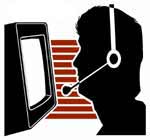As you sit here reading this article, there are three guys you need to thank for how you are reading this. No, it's not Tim Berners-Lee, Bill Gates or even Al Gore. Yes, they all say they had a hand in the creation of the internet as we know it today, but without the efforts of three other guys, sixty years ago, Berners-Lee, Gates and Gore would have been dealing with computers the size of houses and office buildings. The guys you should thank are John Bardeen, Walter Brattain and William Shockley, scientists at Bell Labs. On December 16, sixty years ago, they built the first transistor. The transistor led to a whole new world of electronic devices from televisions, computers, cell phones and MP3 players. Computers, which were developed during World War II, were used for doing the time consuming math involved in calculating artillery coordinates. These computers were very large. The ENIAC, which was filled with vacuum tubes, weighed 28 tons, and consumed 170,000 watts of electricity. Your average modern calculator has more power. The vacuum tubes acted as on /off switches keeping of the binary ones and zeros. While it worked, it was very inefficient and expensive. If computers were going to be used in business and communication, the tubes needed to be replaced with an electronic switch. That switch was the transistor. On that December day, Bardeen and Brattain, built the world's first transistor. Their device, called a point contract transistor, conducted electricity and amplified signals, a job then currently handled by bulky and delicate vacuum tubes and other components. Their colleague Shockley followed soon after with junction transistors. Although Bardeen and Brattain were first, Shockley's device became the basis for the electronic circuit we know today. The transistor led to the creation of Silicon Valley and companies like Intel and Texas Instruments. Transistors' small size and low power made them an ideal candidate to replace the bulky vacuum tubes then used to amplify electrical signals and switch electrical currents. Bell Labs saw them as a replacement for clattering telephone switches. Transistors eventually found their way into portable radios and other electronic devices, and are most prominently used as the building blocks of integrated circuits and are the foundation of microprocessors, memory chips and other kinds of semiconductor devices. In the mid sixties, as transistors got smaller and smaller, Intel's Gordon Moore proposed what would become known as Moore's Law. The "law" states that the number of transistors that could be put on an electronic circuit would double every two years. Pundits have long predicated that Moore's Law would soon fail as the physical limitations of how small things can be, would stop the rising number of transistors. Each year brought new designs and manufacturing techniques that enabled smaller and smaller transistors and proved the pundits wrong. From the simple beginning of a single transistor, sixty years ago, our world has been changed. Everything from music, television, movies, business, medical care and communications has been transformed by what three guys did. So take time out to thank the millions of tiny transistors in your phone.
Top of Page
Back to Great Lakes Geek News | 
